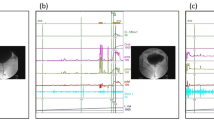Abstract
Fifty-six patients 5.9–15.2 years old with dysfunctional elimination syndrome (DES) unimproved by previous therapies were randomly distributed into two voiding training programs: group 1 contained 26 patients submitted to 24 training sessions over a 3-month period; group 2 contained 30 patients submitted to 16 sessions over a 2-month period. Both groups adhered to a voiding and drinking schedule, received instruction on adequate toilet posture, were reinforced through the maintenance of voiding diaries, and went through proprioceptive and pelvic floor muscle training (Kegel exercises). Group 2 patients also received biofeedback therapy. Clinical evaluation was carried out before each program’s initiation and 1, 6, and 12 months after each program’s termination. All patients were submitted to renal ultrasonography and dynamic ultrasonography before and 6 months after each program’s conclusion. Millivoltage recordings of pelvic floor muscles were compared before and after training. Urinary continence was improved after completion of either training program. Only those patients who received biofeedback training showed a significant decrease in postvoiding residual (PVR) urine as detected by dynamic ultrasonography. Our results show that either training regime can reduce episodic urinary incontinence and urinary tract infection but that further study is required to identify the optimal training duration.

Similar content being viewed by others

References
Koff SA, Wagner TT, Jayanthi VR (1998) The relationship among dysfunctional elimination syndromes, primary vesicoureteral reflux and urinary tract infections in children. J Urol 160:1019–1022
Elder JS (2004) Review of panel discussions. J Urol 171:2672–2679
Bauer SB (2002) Special considerations of the overactive bladder in children. Urology 60(suppl 1):43–48
De Paepe H, Renson C, Laecke, Raes A, Vande Walle J, Hoebeke P (2000) Pelvic-floor therapy and toilet training in young children with dysfunctional voiding and obstipation. BJU Int 85:889–893
Wiener JS, Mischca TS, Hampton J, King LR, Surwit R, Edwards CL (2000) Long term efficacy of simple behavioral therapy for daytime wetting in children. J Urol 164:786–790
Filgueiras MFTF, Lima EM, Sanchez TM, Goulart EMA, Menezes AC, Pires CR (2003) Bladder Dysfunction: Diagnosis with dynamic US. Radiology 227:340–344
Rickwood AM (1990) Investigations. In: Borzyskowski M, Mundy AR (Eds.) Neuropathic bladder in childhood, Oxford, Blackwell Scientific Publication Ltd., pp 10–26
Houle AM, Gilmour RF, Churchill BM, Gaumond M, Bissonnette B (1993) What volume can a child normally store in the bladder at a safe pressure? J Urol 149:561–564
Mattsson S (1994) Voiding frequency, volume and intervals in healthy school children. Scand J Urol Nephrol 28:1–11
De Paepe H, Hoebeke P, Renson C, Van Laecke E, Raes A, Van Hoecke E, Van Daele J, Vande Walle J (1998) Pelvic floor therapy in girls with recurrent urinary tract infections and dysfunctional voiding. Br J Urol 81:109–113
De Paepe H, Renson C, Hoebeke P, Raes A, Van Laecke E, Vande Walle J (2002) The role of pelvic floor therapy in the treatment of lower urinary tract dysfunction in children. Scand J Urol Nephrol 36:260–267
Porena M, Costatini E, Rociola W, Mearini E (2000) Biofeedback successfully cures detrusor-sphincter dyssynergia in pediatric patients. J Urol 163:1927–1931
Hoebeke P, Vande Walle J, Theunis M, De Paepe H, Oosterlinck W, Renson C (1996) Outpatient pelvic floor therapy in girls with daytime incontinence and dysfunctional voiding. Urology 48:923–927
McKenna PH, Herndon CD, Connery S, Ferrer FA (1999) Pelvic-floor muscle retraining for pediatric voiding dysfunction using interactive computer games. J Urol 162:1056–1062
Kegel AH (1948) Progressive resistance exercises in the functional restoration of the muscles. Am J Obstet Gynecol 56:238–248
Burgio KL, Whitehead WE, Engel BT (1985) Urinary incontinence in the elderly. Ann Intern Med 104:507–515
Wennergren H, Oberg B (1995) Pelvic floor exercises for children: a method of treating dysfunctional voiding. Br J Urol 76:9–15
Maizels M, King LR, Firlit CF (1979) Urodynamic biofeedback: a new approach to treat vesical sphincter dyssynergia. J Urol 122:205–208
Berghmans LC, Hendricks HJ, Bo K, Hay-Smith EJ, de Bie RA, van Waalwijk, van Doorn ES (1998) Conservative treatment of stress urinary incontinence in women. A systematic review of randomized clinical trials. Br J Urol 82:181–191
Morkved S, Bo K, Fjortoft T (2002) Effect of adding biofeedback to pelvic floor muscle training to treat urodynamic stress incontinence. Obstet Gynecol 100:730–739
Gladh G, Mattsson S, Lindstrom S (2001) Anogenital electrical stimulation as treatment of urge incontinence in children. BJU Int 87:366–371
Clayden GS (1992) Management of chronic constipation. Arch Dis Child 67:340–344
Loening-Baucke V (1997) Urinary incontinence and urinary tract infection and their resolution with treatment of chronic constipation of childhood. Pediatrics 100:228–232
Schulman SL, Plachter N, Kodman-Jones C (1999) Comprehensive management of dysfunctional voiding. Pediatrics 103:1353–1358
Schulman SL, Von zuben FC, Plachter N, Kodman-Jones C (2001) Biofeedback methodology: does it matter how we teach children how to relax the pelvic floor during voiding? J Urol 166:2423–2426
Nelson JD, Cooper CS, Boyt MA, Hawtrey CE, Austin JC (2004) Improved uroflow parameters and post- void residual following biofeedback therapy in pediatric patients with dysfunctional voiding does not correspond to outcome. J Urol 172:1653–1656
Kjølseth D, Madsen B, Knudsen LM, Norgaard JP, Djurhuus JC (1994) Biofeedback treatment of children and adults with idiopathic detrusor instability. Scand J Urol Nephrol 28:243–247
Yamanishi T, Yasuda K, Murayama N, Sakakibara R, Uchiyama T, Ito H (2000) Biofeedback training for detrusor overactivity in children J Urol 164:1686–1690
Sureshkumar P, Bower W, Craig JC, Knight JF (2003) Treatment of daytime urinary incontinence in children: a systematic review of randomized controlled trials. J Urol 170:196–200
Acknowledgements
We extend grateful thanks to E. Baracho, PT, and Chris Fields for their generous help and contributions to the present study. This study was partially supported by the Brazilian National Research Council (CNPq) with Junia Araújo and Gisele Magnus the recipients of a CNPq fellowship.
Author information
Authors and Affiliations
Corresponding author
Rights and permissions
About this article
Cite this article
Vasconcelos, M., Lima, E., Caiafa, L. et al. Voiding dysfunction in children. Pelvic-floor exercises or biofeedback therapy: a randomized study. Pediatr Nephrol 21, 1858–1864 (2006). https://doi.org/10.1007/s00467-006-0277-1
Received:
Revised:
Accepted:
Published:
Issue Date:
DOI: https://doi.org/10.1007/s00467-006-0277-1



